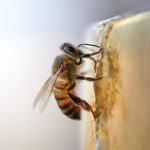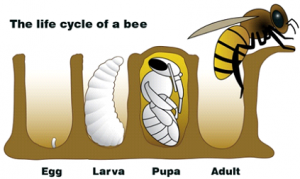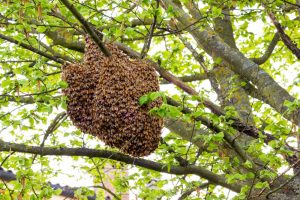
Bees in Melbourne
Luckily, in Australia bees are still a common insect. There are over 2,000 bee species and they play a valuable role in our ecosystem. They pollinate many of our food crops and are most often attracted to flowers. This can help keep them away from humans for the most part, but they do pose a problem when they nest close to homes and workplaces.
Bees are not generally aggressive insects and you are less likely to be attacked by a bee than a wasp or hornet. The biggest issue for humans when it comes to bees is that many people are allergic to them.
This makes the presence of bees a high risk, especially in public places such as schools, markets or hospitality establishments.
In Melbourne, bees swarming & being on the move is a common occurrence during the warmer months.
EPC – Enviro Pest Control provide bee treatments in Melbourne, depending on the environment, for commercial and domestic clients, because the risk of someone being stung by a bee and having an allergic reaction is not a risk you want to take.
Bee species most commonly found in Melbourne by EPC – Enviro Pest Control are:
- European or Western Honey Bee (Apis mellifera)
- Invasive species, the most common of the honey bees world- wide
- Approx. 12 mm long
- Builds hives in hollow trees, wall cavities and roof spaces, although can also build hanging nests
- Non aggressive
- Blue Banded Bee or Mortar or Masonry Bee (Amegilla)
- Approx.8-13 mm long
- Furry Red-Brown thorax and glittering stripes of blue across their abdomens, females 4 stripes males five
- Build nests in shallow burrows but may also nest in soft mortar or earth banks under houses
- Females build individual burrows but many bees may nest together in the one area, males ‘roost’ on plants overnight
- Non-aggressive
- Teddy Bear Bees (Amegilla)
- Approx. 7-15 mm
- Build shallow nests in soft soil and sometimes underneath houses
- Females build individual burrows but many bees may nest together in the one area
- Furry brown thorax but as these bees age the hair on the top of their thorax becomes worn, leaving a bald spot
- Leafcutter Bees (Megachile)
- 6-15 mm long
- Cut neat circular discs in rows on the edges of soft leaves to use as nest building materials, (particularly roses and buddlejas).
Signs of allergic reaction to a Bee sting
Allergic reactions to bee stings are serious!! In the case of a person suffering an allergic reaction EPC – Enviro Pest Control recommends immediately seeking medical attention. Some signs that a person is having an allergic reaction to a bee sting are:
- Very painful sting
- Swelling around the throat and mouth
- Difficulty breathing
- Irregularity of pulse
- Nausea and / or vomiting
- Dizziness or a lightheaded feeling
EPC – Enviro Pest Control recommends immediately seeking medical attention.
Breeding and Life Cycle of Bees
For all types of bees there are four stages in their life cycle – egg>larva>pupa>adult.

Signs of Bee presence
 Bees often build nests close to where humans live or work. Australian native bee species are nearly all solitary. Females build individual burrows but many bees may nest together in the one area. Solitary bees can vary in size in size, shape and colour. The bees EPC – Enviro Pest Control usually finds in people’s gardens are not native bees, they’re the commercial honey bee, Apis Mellifera, which were imported from Europe in 1822 for honey production.
Bees often build nests close to where humans live or work. Australian native bee species are nearly all solitary. Females build individual burrows but many bees may nest together in the one area. Solitary bees can vary in size in size, shape and colour. The bees EPC – Enviro Pest Control usually finds in people’s gardens are not native bees, they’re the commercial honey bee, Apis Mellifera, which were imported from Europe in 1822 for honey production.
The constant coming and going of bees to a nest usually makes them relatively easy to find. Look for:
- Live or dead insects
- Nests – In trees, under the eaves, roof voids, sheds, bushes etc.
- Noise – constant humming or buzzing
- Swarm – This consists only of fully grown adult bees that hang off a branch or in a bush temporarily. A few of these insects scout for a new home while the others remain in this cluster and they all move to their new home once the scouting bees find one.
EPC’s Fun facts about Bees
- Bees love blue and love cluster plants like lavender and rosemary.
- A bee produces a teaspoon of honey (about 5 grams) in her lifetime.
- To produce a kilogram of honey, bees fly the equivalent of three times around the world in air miles.
- Carpenter Bees, Blue-banded Bees and Teddy Bear Bees have a special way of pollinating flowers. They vibrate a flower so vigorously that pollen locked away in little capsules explodes out. A static charge draws the pollen back to cover their bodies.
Why Hire EPC – Enviro Pest Control To Remove Bees?
At EPC – Enviro Pest Control Pty Ltd, we have a lot of experience when it comes to bee treatments in Melbourne. If you notice that the number of bees you see is increasing, there is a chance that there might be a nest around or in your property. To eliminate the risk of yourself, your children or pets being stung, EPC – Enviro Pest Control need to inspect all structures at your home or place of business and treat the infestation with our “control and elimination” service. EPC – Enviro Pest Control’s technicians are well trained and will ensure that nobody is at risk of being stung before beginning the treatment. Other reasons to hire us to attend to your bee treatment needs are:
- Experienced commercial pest controllers
- Fast service
- Professionally presented staff
- We arrive on time!
- Fair priced and high quality service
- Use the right chemicals for the job
If you need to speak to a professional about bee treatments in Melbourne, call EPC – Enviro Pest Control (03) 9988 5066 now.
